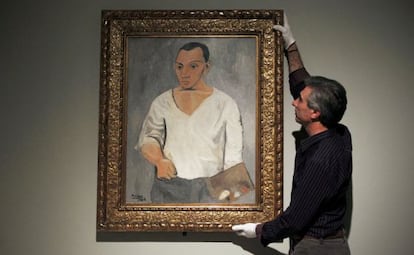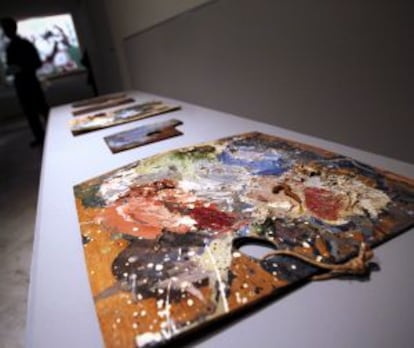The spaces that spawned a thousand Picasso masterpieces
Fundación Mapfre show examines the artist's relationship with his workshop

Dry, brittle paintbrushes and a palette full of colorful blotches bid visitors farewell to the new Picasso exhibition that opens at the Fundación Mapfre in Madrid this coming Wednesday.
The items are precariously balanced in a corner of the last room of the show, in the exact same positions as the genius left them when he walked out of his studio for the final time, claim his heirs.
Picasso. En el taller (or, Picasso. In the workshop) aims to demonstrate that the extraordinary collection of Picasso's obsessions it accumulates was something more than a myth constructed by the 20th century and conveniently packaged for consumption in the 21st. That Picasso was really and truly like this in his private life.
After examining the 80 canvases, 60 drawings and prints, 20 photographs and over a dozen palettes on display at the foundation, the idea is that visitors will come away thinking that the artist from Málaga not only worked very hard -- and very successfully -- at embodying the ideal artist for the benefit of humanity and posterity, but that he also worked equally hard at selling this story to himself.

Definitive proof is the fact that the painter-and-model theme "broke forcefully into his work beginning in 1927 and remained present until the end," notes exhibition curator Maite Ocaña, who decided to focus the show on "the spaces of creative work, which also afford a faithful, daily representation of his day-to-day life."
In other words, this is a show about the genius's workplace routines, although above all it talks about his attitudes and habits in the creative intimacy of his workshop. Which, in Picasso's case, is the same as saying the supreme place of his existence. He himself termed it "my interior landscape."
The seven decades spanned by the exhibition, from the Cubism of 1918 to one of his last self-portraits in striped pants, include references to locations that are the stuff of legend for art lovers, including Number 23 bis de la Rue La Boétie; the châteaux of Boisgeloup and Vauvenargues; the spacious studio at Grand-Augustins, where he lived with Dora Maar and painted the antiwar mural Guernica ; the villas of La Galloise and La Californie in Provence; and the late-life refuge of Notre-Dame-de-Vie, in Mougins.
Evidence of his stay at all of these places has arrived at the Fundación Mapfre courtesy of museums and private collections all over the globe -- though sadly the Tehran Museum of Contemporary Art, which was due to be one of the contributors to the show, was prevented from loaning the mysterious Picassos collected by former Queen Farah Diba because of an insurance mix-up.
Among the works that did make it to Madrid is his 1906 Self-Portrait with Palette, a masterpiece usually on display at the Philadelphia Museum of Art, which welcomes visitors to the exhibition and functions as a foreword to the tale about to unfold inside.
The show is divided in two, representing two female figures who were fundamental in the life of the artist: Marie-Thérèse Walter (on the ground floor), and Jacqueline Roque, whom Picasso depicted an estimated 400 times (upstairs).
Before the models arrived, all the attention in the workshop was focused on Cubist themes: still lifes, pipes, glasses, face masks and guitars. As a firm believer in the bourgeois ideal, Picasso always surrounded himself with beautiful things and kept them within easy reach: women, gallery owners, art dealers, furniture, views on the Mediterranean and photographers. One circular room in the show displays black-and-white photographs of those happy days, some of which were taken by Jacqueline -- the woman who kicked off Picasso's interest in models and the universe of his own workspace.
The exhibition reflects this fascination with his own working area and his obsession with capturing the atmosphere and the relations within it, as suggested by his version of Velázquez's 1656 masterpiece Las Meninas, which hangs inside one of the rooms, and by his Suite Vollard, which was vaguely inspired by writer Honoré de Balzac's painter character, who was bent on capturing life though female beauty.
The opposition between the painter, an increasingly old and voyeuristic figure -- in the end he is nothing more than a presence in the upper right-hand corner of the canvas -- and his increasingly young and voluptuous models prompted curator Ocaña, a former director of the Picasso Museum in Barcelona, to reflect on "the evanescence of the passage of time." But visitors to the show (voyeurs themselves) will more likely be left with a sense of melancholic despair on the part of the ageing Picasso.
Picasso. En el taller. February 12 to May 11 at Fundación Mapfre, Sala Recoletos, Paseo de Recoletos 23, Madrid. www.fundacionmapfre.org
Tu suscripción se está usando en otro dispositivo
¿Quieres añadir otro usuario a tu suscripción?
Si continúas leyendo en este dispositivo, no se podrá leer en el otro.
FlechaTu suscripción se está usando en otro dispositivo y solo puedes acceder a EL PAÍS desde un dispositivo a la vez.
Si quieres compartir tu cuenta, cambia tu suscripción a la modalidad Premium, así podrás añadir otro usuario. Cada uno accederá con su propia cuenta de email, lo que os permitirá personalizar vuestra experiencia en EL PAÍS.
¿Tienes una suscripción de empresa? Accede aquí para contratar más cuentas.
En el caso de no saber quién está usando tu cuenta, te recomendamos cambiar tu contraseña aquí.
Si decides continuar compartiendo tu cuenta, este mensaje se mostrará en tu dispositivo y en el de la otra persona que está usando tu cuenta de forma indefinida, afectando a tu experiencia de lectura. Puedes consultar aquí los términos y condiciones de la suscripción digital.
Últimas noticias
Maduro pleads not guilty before the federal court in New York: ‘I am still the president of Venezuela’
A new test can detect Alzheimer’s from a finger prick
UN team enters Sudanese city of El Fasher after paramilitary massacre: ‘It’s like a ghost town’
A recipe for resistance: Indigenous peoples politicize their struggles from the kitchen
Most viewed
- Gilles Lipovetsky: ‘If you want to live better and fall in love, take Prozac, don’t look to philosophy’
- Alain Aspect, Nobel laureate in physics: ‘Einstein was so smart that he would have had to recognize quantum entanglement’
- Alvin Hellerstein, a 92-year-old judge appointed by Bill Clinton, to preside over Maduro’s trial in New York
- Why oil has been at the center of Venezuela-US conflicts for decades
- Cuba confirms death of 32 of its citizens in the US attack against Venezuela









































